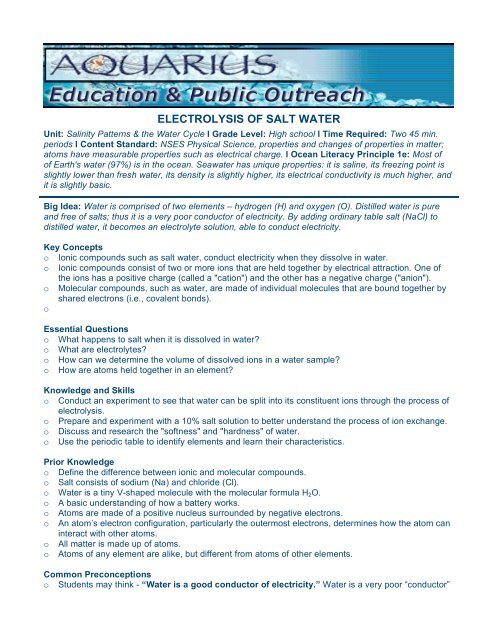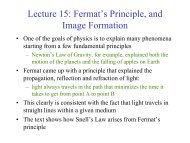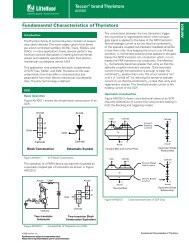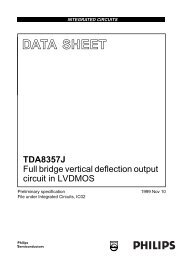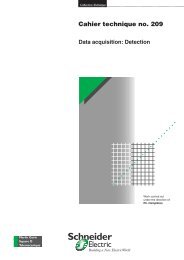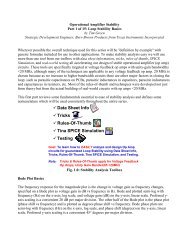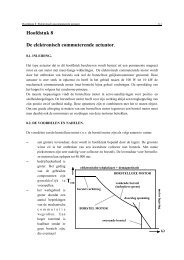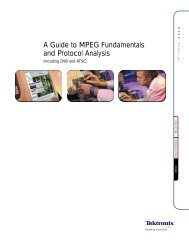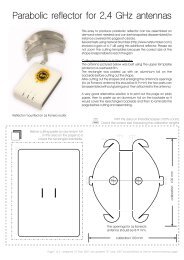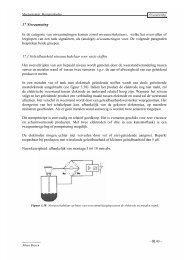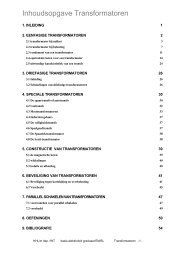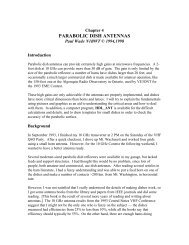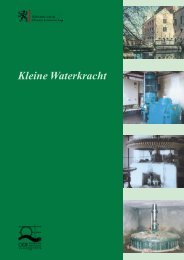ELECTROLYSIS OF SALT WATER - Educypedia
ELECTROLYSIS OF SALT WATER - Educypedia
ELECTROLYSIS OF SALT WATER - Educypedia
Create successful ePaper yourself
Turn your PDF publications into a flip-book with our unique Google optimized e-Paper software.
<strong>ELECTROLYSIS</strong> <strong>OF</strong> <strong>SALT</strong> <strong>WATER</strong><br />
Unit: Salinity Patterns & the Water Cycle l Grade Level: High school l Time Required: Two 45 min.<br />
periods l Content Standard: NSES Physical Science, properties and changes of properties in matter;<br />
atoms have measurable properties such as electrical charge. l Ocean Literacy Principle 1e: Most of<br />
of Earth's water (97%) is in the ocean. Seawater has unique properties: it is saline, its freezing point is<br />
slightly lower than fresh water, its density is slightly higher, its electrical conductivity is much higher, and<br />
it is slightly basic.<br />
Big Idea: Water is comprised of two elements – hydrogen (H) and oxygen (O). Distilled water is pure<br />
and free of salts; thus it is a very poor conductor of electricity. By adding ordinary table salt (NaCl) to<br />
distilled water, it becomes an electrolyte solution, able to conduct electricity.<br />
Key Concepts<br />
o Ionic compounds such as salt water, conduct electricity when they dissolve in water.<br />
o Ionic compounds consist of two or more ions that are held together by electrical attraction. One of<br />
the ions has a positive charge (called a "cation") and the other has a negative charge ("anion").<br />
o Molecular compounds, such as water, are made of individual molecules that are bound together by<br />
shared electrons (i.e., covalent bonds).<br />
o<br />
Essential Questions<br />
o What happens to salt when it is dissolved in water?<br />
o What are electrolytes?<br />
o How can we determine the volume of dissolved ions in a water sample?<br />
o How are atoms held together in an element?<br />
Knowledge and Skills<br />
o Conduct an experiment to see that water can be split into its constituent ions through the process of<br />
electrolysis.<br />
o Prepare and experiment with a 10% salt solution to better understand the process of ion exchange.<br />
o Discuss and research the "softness" and "hardness" of water.<br />
o Use the periodic table to identify elements and learn their characteristics.<br />
Prior Knowledge<br />
o Define the difference between ionic and molecular compounds.<br />
o Salt consists of sodium (Na) and chloride (Cl).<br />
o Water is a tiny V-shaped molecule with the molecular formula H2O.<br />
o A basic understanding of how a battery works.<br />
o Atoms are made of a positive nucleus surrounded by negative electrons.<br />
o An atom’s electron configuration, particularly the outermost electrons, determines how the atom can<br />
interact with other atoms.<br />
o All matter is made up of atoms.<br />
o Atoms of any element are alike, but different from atoms of other elements.<br />
Common Preconceptions<br />
o Students may think - “Water is a good conductor of electricity.” Water is a very poor “conductor”
of electricity. (The ionization constant for water is very small.) The reason it is dangerous to insert a<br />
light bulb while standing in a puddle of water is that water is a great solvent for ionic compounds.<br />
Tap water and fresh water typically contain dissolved ions in sufficient concentrations to enable the<br />
solution to be conductive. However, ions in solution carry the charge and are thereby responsible for<br />
the current, not the water itself.<br />
o Students may think - “Electrons can flow through solutions.” In “conduction of electricity” through<br />
solutions, electrons themselves do not pass through the solutions. Rather, charge balance is<br />
maintained in the solution by movement of cations and anions toward the electrodes where charge<br />
transfer takes place at the solution interface.<br />
Concept Map: This lesson and activity relates to the branch “Phases of Water” from the comprehensive<br />
Aquarius Concept Map – Water & its patterns on Earth’s surface.<br />
Background:<br />
In chemistry, electrolysis is a method of separating bonded elements and compounds by passing an<br />
electric current through them. An ionic compound, in this case salt, is dissolved with an appropriate<br />
solvent, such as water, so that its ions are available in the liquid. An electrical current is applied between<br />
a pair of inert electrodes immersed in the liquid. The negatively charged electrode is called the cathode,<br />
and the positively charged one the anode. Each electrode attracts ions which are of the opposite<br />
charge. Therefore, positively charged ions (called cations) move towards the cathode, while negatively<br />
charged ions (termed anions) move toward the anode. The energy required to separate the ions, and<br />
cause them to gather at the respective electrodes, is provided by an electrical power supply. At the<br />
probes, electrons are absorbed or released by the ions, forming a collection of the desired element or<br />
compound.<br />
One important use of electrolysis is to produce hydrogen. The reaction that occurs is<br />
2H2O(aq) → 2H2(g) + O2(g). This has been suggested as a way of shifting society towards using<br />
hydrogen as an energy carrier for powering electric motors and internal combustion engines.<br />
Electrolysis of water can be achieved in a simple hands-on project, where electricity from a battery is<br />
passed through a cup of water (in practice a saltwater solution or other electrolyte will need to be used<br />
otherwise no result will be observed). Electrolysis of an aqueous solution of table salt (NaCl, or sodium<br />
chloride) produces aqueous sodium hydroxide and chlorine, although usually only in minute amounts.<br />
NaCl(aq) can be reliably electrolysed to produce hydrogen. Hydrogen gas will be seen to bubble up at<br />
the cathode, and chlorine gas will bubble at the anode.
Faraday's law of electrolysis states that:<br />
▪ The mass of a substance produced at an electrode during electrolysis is proportional to the number of<br />
moles of electrons (the quantity of electricity) transferred at that electrode<br />
▪ The number of Faradays of electric charge required to discharge one mole of substance at an<br />
electrode is equal to the number of "excess" elementary charges on that ion<br />
These two statements are often considered as separate laws: Faraday's 1st and 2nd laws of<br />
electrolysis.<br />
Background source – Wikipedia<br />
http://en.wikipedia.org/wiki/Electrolysis<br />
Materials: Periodic Table, table salt, distilled water, measuring apparatus; Per Student Group: 9-Volt<br />
battery, two electrodes (e.g., copper strips or two #2 pencils each sharpened at both ends), electrical<br />
wire, glass beakers or ceramic saucers, electrical tape (optional)<br />
Preparation: “The Nature of Salt” is a good preparatory activity to acquaint students with the ionic<br />
bonds that occur between Na+ and Cl- ions. Lab Safety Reminder – Students should wear goggles at<br />
all times during the experiment process. All basic lab safety guidelines for your classroom/lab should be<br />
followed.<br />
Activity<br />
o Have the students read the "Background" section (above) and then find hydrogen and oxygen on a<br />
Periodic Table. If students are not already familiar with the general relationship between an<br />
element's Periodic Table Group Number and its tendency to gain or lose electron(s), have them<br />
research this topic. The relevant Groups for the elements H and O:<br />
o Group 1 (or I) Elements – Have one electron in their outer shell. Each element in this group<br />
has a tendency to lose a single electron to form a singly charged positive ion. Other than<br />
Hydrogen, the other elements in this group are known as "Alkali Metals": Lithium, Sodium,<br />
Potassium, Rubidium, Cesium, and Francium. Hydrogen is not metallic and thus, on some<br />
Periodic Tables, is shown apart from the Group 1 elements altogether.<br />
o Group 16 (or VIA) Elements – Have six electrons in their outer shell. Each element in this<br />
group has a tendency to gain two electrons to form a doubly charged negative ion. Elements<br />
in this group include Oxygen, Sulphur, Selenium, Tellurium, and Polonium. These are known<br />
as "Chalcogens" or the "Oxygen family." Their compounds are often called "ore formers."<br />
o This exercise should help students understand why the chemical formula for water is H2O. However,<br />
they should also understand that hydrogen and oxygen occur in various ionic forms:<br />
o Hydrogen can be a cation (i.e., positively charged as H+) or, less commonly, an anion (i.e.,<br />
negatively charged H- known as a "hydride").<br />
o Oxygen can be a doubly charged anion called an "oxide" (i.e., O 2- ). In addition, oxygen is<br />
often paired with a single hydrogen ion to form a "hydroxide" anion (i.e., OH-).<br />
o Water is an example of a "molecular compound." Atoms in a molecular compound are bound<br />
together by shared electrons (i.e., covalent bonds). Water can be split into its constituent elements<br />
by passing an electrical current between the positive and negative poles of a battery that is<br />
immersed in water. This process is called "electrolysis"; however, rather than splitting water into<br />
pure hydrogen and pure oxygen, water molecules naturally split into H+ and OH- ions.<br />
o If you do not conduct the preparatory experiment "The Nature of Salt," review with students the ionic<br />
bonds involved in the formation of NaCl. Guided by the Periodic Table, ask them to determine the<br />
ionic charge of sodium (Na+) and chlorine (Cl-) in solution.<br />
o Students will prepare a percent composition by mass, specifically a 10% salt solution. Write the<br />
following sentence on the board: "Percent composition by mass is the mass of the solute divided by<br />
the mass of the solution (i.e., mass of the solute plus mass of the solvent), multiplied by 100."<br />
o What is the solute? (Table salt or sodium chloride)<br />
o What is the solvent? (Distilled water)<br />
o Within a group discussion, come up with the equation used to calculate the mass of salt needed to
e added to water to make a 10% salt solution:<br />
_____ grams of NaCl<br />
( _____ grams of NaCl + _____ grams of water ) X 100 = 10% NaCl solution<br />
(One correct ratio is 10 grams of NaCl and 90 grams of water)<br />
o Connect the electrodes to the + and - terminals of a 9-volt battery. Place the other ends of the<br />
electrodes in the 10% salt solution. See diagram below. Gas bubbles will appear on the immersed<br />
electrodes.<br />
o What to expect:<br />
• As the electricity from the battery passes through and between the electrodes, the water<br />
splits into hydrogen and chlorine gas, which collect as very tiny bubbles around the electrode<br />
tips.<br />
• Hydrogen collects around the cathode and chlorine gas collects around the anode.<br />
• How can you get chlorine from H2O? Sometimes in experiments, a secondary reaction takes<br />
place. This is what happens in this experiment.<br />
• Oxygen is not given off in this experiment. That's because the oxygen atoms from the water<br />
combine in the liquid with the salt to form hydroxyl ions. Salt's chemical formula is NaCl -<br />
sodium chloride. The chorine gas is from the chloride in the salt. The oxygen in the hydroxyl<br />
ions stay in the solution. So what is released in this reaction is not oxygen but is chlorine gas<br />
that collects around the electrode tip.<br />
• In real electrolysis systems, a different solution is used and higher levels of electricity help to<br />
split the water molecules into hydrogen and oxygen without this secondary reaction.<br />
o OPTIONAL: If you have an ampmeter that can be set to the microamp scale, you can begin with<br />
pure distilled water and gradually add salt to the liquid. As you add more salt to the solution,<br />
movement of the needle will indicate increased current flow. The conductivity of a solution is<br />
proportional to the concentration of ions in the solution.<br />
o Ask the students: "Which ions will move towards the cathode?" (Cations, positively charged ions<br />
such as Na+ and H+, will move towards the negatively charged cathode.) "Which ions will move<br />
towards the anode?" (Anions, negatively charged ions such as Cl- and OH-, will move towards the<br />
positively charged anode.) Have the students draw a diagram of the experiment set-up (i.e., similar<br />
to figure in the "Background" section). On their diagram, indicate which ions are located near the<br />
cathode and the anode.<br />
o As a group, discuss the composition of the gases that appear at the cathode and the anode. If<br />
needed, write the following ionic equations for the electrolysis of NaCl solution on the board:
2Cl- => Cl2 + 2e-<br />
2H2O + 2e- => H2 + 2OH-<br />
o The upper equation shows the oxidation (i.e., loss of electrons from an atom) at the anode and<br />
release of chlorine gas (i.e., Cl2). NOTE: Cl- is easier to oxidize than water, thus the product formed<br />
at the cathode is chlorine gas.<br />
o The lower equation shows the reduction (i.e., gain of electrons by an atom) at the cathode and<br />
release of hydrogen gas (i.e., H2). NOTE: Water is easier to reduce than Na+ ions, thus the product<br />
formed at the cathode is hydrogen gas.<br />
o Pose the question: "Given the two equations (above), what is the ionic equation for the overall<br />
reaction?" (2Cl- + 2H2O => Cl2 + H2 + 2OH-)<br />
Assessment / Questions<br />
o Ask the students: "Why did the salt make the water more conductive to electricity?" (The molecules<br />
of salt dissociate into ions of opposite charges. It is the ions that render the water conductive to<br />
electricity. In our experiment, the Na+ and Cl- ions made it possible for the distilled water to conduct<br />
electricity.)<br />
o Ask the students: "Would solid NaCl conduct electricity?" (No. In a solid compound the Na+ or Cl-<br />
ions are strongly attracted to each other; these ionic bonds cannot be broken by an electrical<br />
current.)<br />
o "Would molten NaCl conduct electricity?" (Yes. In liquid form, the ionic bond between the Na+ and<br />
Cl- ions is weakened and thus can become mobile and conduct electricity.)<br />
o "Would tap water conduct electricity?" (Yes. There are enough ions in tap water to conduct<br />
electricity.) Ask the students if they have heard the terms "soft water" and "hard water." Ask them to<br />
discover what types of ions are usually present in "hard water" (calcium and magnesium). Explain<br />
that "water softening" is major industry and ask if they can list reasons why this is the case. (Hard<br />
water requires more soap and detergent for laundering, cleaning and bathing because suds do not<br />
form well. The reaction between soap and hard water results deposits that make fabrics feel harsh<br />
and leave water spots on dishes and utensils. Mineral scale from hard water builds up in hot water<br />
appliances and industrial boilers, reducing energy efficiency and shortening appliance and<br />
equipment life.)<br />
o An independent research project could be assigned that focuses on the water softening<br />
process. A great website for this is the "Salt Institute" (http://www.saltinstitute.org).<br />
o OPTIONAL: To access an animation depicting how ionic compounds such as NaCl dissolve in<br />
water, visit Northland College (Minnesota)'s Department of Biology webpage<br />
(http://www.northland.cc.mn.us/biology/Biology1111/animations/dissolve.html).<br />
o OPTIONAL: To access an interactive animation depicting the interaction of ice, water, and a solute<br />
(e.g., salt), visit the "General Chemistry Online!" webpage, "Why does salt melt ice?"<br />
(http://antoine.frostburg.edu/chem/senese/101/solutions/faq/why-salt-melts-ice.shtml).<br />
o Be sure to raise and lower the temperature and "add solute" by clicking on the banner below<br />
the "dancing" water molecules. Ask students to explain how this animation relates to their<br />
experiment results.<br />
Vocabulary<br />
o anode: A positively charged electrode.<br />
o atom: A chemical unit, composed of protons, neutrons, and electrons, that cannot further break down by<br />
chemical means.<br />
o cathode: A negatively charged electrode.<br />
o compound: A pure substance composed of more than one element.<br />
o conductor: A substance or medium that conducts heat, light, sound, or especially an electric charge.<br />
o covalent bond: A chemical bond that involves sharing of electron pairs.<br />
o electrode: A solid electric conductor through which an electric current enters or leaves an electrolytic cell.<br />
o electron: A negatively charged subatomic particle with a mass of 0.00055 atomic mass units (AMU). By<br />
definition, one AMU is one-twelfth the mass of a carbon-12 atom.<br />
o ion: A charged particle.<br />
o ionic bond: An electrostatic interaction between a cation (+ charged ion) and an anion (- charged ion).
o molecule: A pure substance which results when two or more atoms of a single element share electrons, for<br />
example O2. It can also more loosely refer to a compound, which is a combination of two or more atoms of two<br />
or more different elements, for example H2O.<br />
o oxidation: The loss of electrons by a compound or ion.<br />
o reduction: The gain of electrons by a compound or ion.<br />
Original source: Adapted with permission from the Salt Institute's activity "Salt: The Essence of Life"<br />
(http://www.saltinstitute.org); Glossary definitions from "EverythingBio.com"<br />
Aquarius Education & Public Outreach URL: http://aquarius.nasa.gov/


